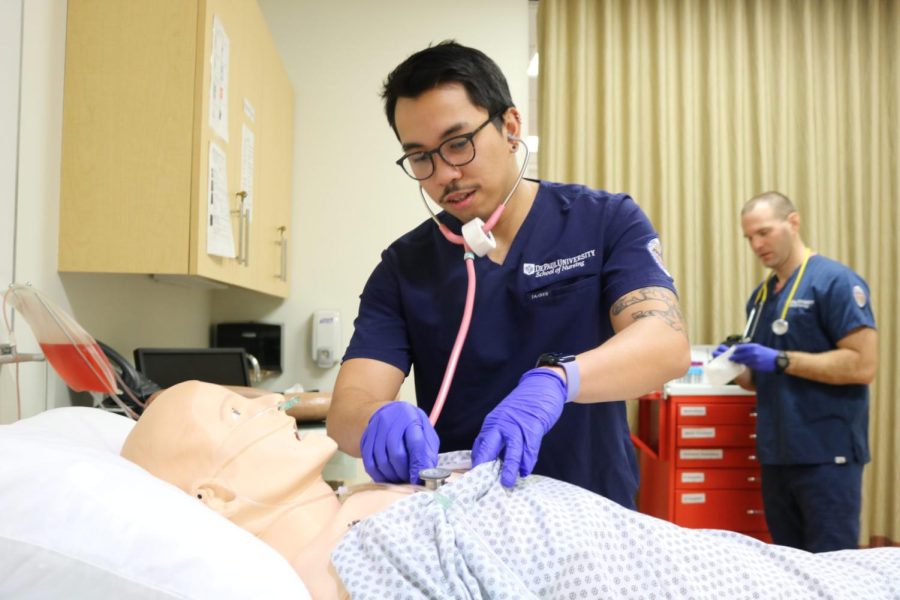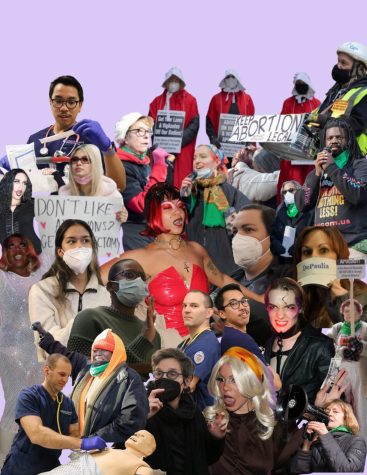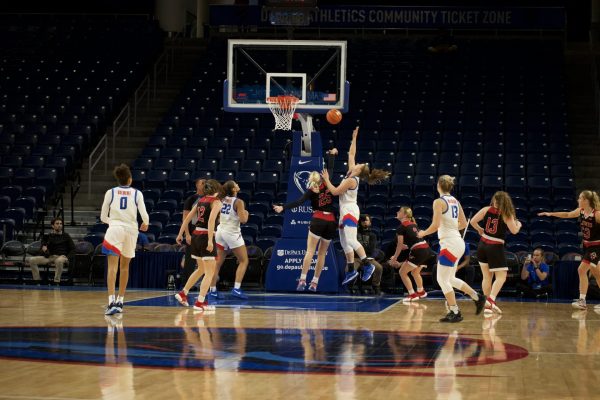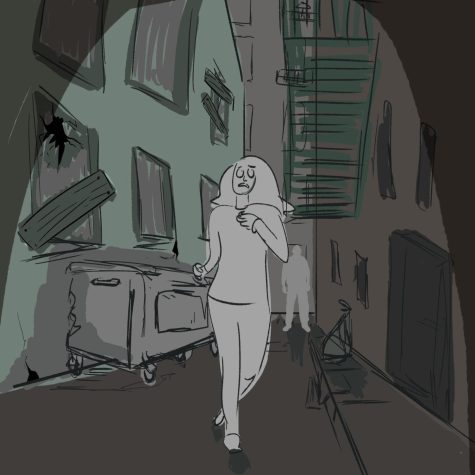Men in nursing
When looking at stock pictures of nurses, a number of things stand out: the friendly smile of a welcoming professional, a stethoscope around their neck and scrubs that come in shades of calming blue.
But while Mark Comia, a graduate assistant at DePaul’s School of Nursing, fits the description of a nurse when he steps into a patient’s room, he is often mistaken for the doctor.
“It’s definitely common for parents to confuse me with a doctor,” said Comia, who currently works in a pediatric rotation as well as in OB-GYN. “I thought that was like, really funny, and kind of also demeaning to the nursing profession just because of like, ‘oh, wow, it’s a guy, it might be the doctor,’ and then the parents started talking about the kids and asking me questions. I was like, ‘let me just introduce myself to you. One, I’m Mark, and two, I’m not your doctor or your kids’ doctor, I’m a nursing student.’”
One of Comia’s work colleagues, Joseph Torres, worked as a nurse in Texas for two years before recently moving to Chicago.
“Back in Texas, it was actually kind of common for patients to ask me when we were getting to know each other, like, they would ask me like, ‘oh, are you training to become a doctor?’ or like, ‘Oh, you don’t want to become a doctor?’” Torres said. “Which I mean, at first, I didn’t think much of it, but, the more I thought about it as the years went on, I was like, ‘oh, that’s kind of like, a bad feeling.’”
“When people would ask me that, I guess people expect men to be the doctor, they think as nursing like a woman’s job — which [it] isn’t, it never has been,” Torres added.
When not being mistaken for doctors, male nurses may face other misconceptions and stereotypes, like assumptions about their sexuality.
Comia recalls one incident with a patient who assumed all male nurses were gay.
“One of the guy patients, a cis male patient, wanted a female nurse because he thinks that all male nurses are gay,” Comia said. “He called slurs towards all the male nurses, even the cis male heterosexual ones. That was disheartening, like, we want to care for this patient, but how could you care for a patient that doesn’t even respect you?”
One article by Reuters found that fictional depictions of male nurses may reinforce stereotypes of male nurses being “gay” or “unmasculine.”
“Male nursing, like in general in society, is sort of viewed as a feminine role,” said ER technician and DePaul nursing student Matthew Goggin. “So it’s not viewed as particularly prestigious or attractive. Like in the Ben Stiller movie, ‘Meet the Parents.’ He’s a nurse and the dad picks on him about it.”
While Goggin has seen depictions of family being skeptical of male nurses in media, he has not experienced that during his career change.
“I feel like I have not personally experienced that at all,” Goggin said. “Everyone has been very supportive. Maybe I’m lucky to start my nursing career during Covid when like, everyone is giving all the love to nurses.”
Demand for nurses, regardless of gender, is projected to increase 9 percent from 2020 to 2030, according to the Bureau of Labor Statistics. Additionally, an article from Southern New Hampshire University notes that there are more men in nursing now than in any time in history, with 12 percent of registered nurses identifying as men.
At DePaul, the School of Nursing is seeing what must be done to create and foster an inclusive environment.
Dr. Kashica Webber-Ritchey works as the chair of the Curriculum Committee, which oversees the School of Nursing’s curriculum.
“We always want to create within nursing, an inclusive environment so we can prevent those stereotypes,” Webber-Ritchey said. “We still have some work to do, because those types of stereotypes still exist.”
As part of addressing stereotypes and creating a more inclusive environment for all students, Webber-Ritchey and the Curriculum Committee implemented a diversity statement in the School of Nursing’s handbook.
“There was a slogan by Florence Nightingale, where it’s like, ‘every woman is a nurse.’ And so we have to move past that,” Webber-Ritchey said. “Nursing is inclusive to everyone — we want everyone to be a nurse, nurses are males and females, and you know, and also outside of just gender identity, we want an inclusive environment.”
Within the School of Nursing, professor Gre Gonzales teaches in the master’s Entry to Nursing Practice program. In Gonzales’ 12 years of practicing as a nurse, he has not encountered issues relating to his gender — but he attributes that to Chicago’s geographical setting and changes in thinking.
“I think, in general, people are just more accepting of everyone,” Gonzales said. “At the end of the day, it doesn’t have anything to do with your role. It’s really how you interact with people, how you care for them and how you respect them.”
Gonzales believes DePaul’s nursing curriculum prepares future nurses for interacting with people of different backgrounds.
“I think we are creating nurses who are, you know, globally competitive, who are competent, and nurses who know how to deal with different types of people from all backgrounds. So I think that’s what it is, that our nurses are prepared,” Gonzales said. “That’s why it does not matter whether they’re male, female or, you know, gender fluid, that patients accept their care, just because I think one factor is our nurses are going into the nursing field prepared, knowing how to interact with different types of people.”
Despite the negative encounters Comia has had, he is glad he has chosen the right profession for himself and hopes that the number of male nurses in the field continues to grow. He also hopes to make a positive impact in the field following his master’s program.
“I know for myself that I’m going to go back and continue my education again after finishing this master’s program, and I’m going to be thinking of like ways to like incorporate, like some sort of like a male course of like debunking disparities and like stereotypes and prejudice,” Comia said. “We can talk about it all day, but some people want data, some people are more critical and analytical in a sense that, if there is no data, it is not happening. I think it just takes like one of those things where like, ‘if no one’s going to do it, who is?’ kind of thing.”
Comia’s path in debunking stereotypes and prejudice begins on the nursing floor: as part of his duties during his pediatric rotation, one of Comia’s responsibilities is swaddling babies. He also teaches the fathers of newborns how to swaddle their children as well.
“Dads seeing male nurses too also kind of brightens my day, because I’m just glad that they’re seeing a change,” Comia said. “They’re not just like hearing that there are male nurses, they are actually seeing male nurses on the floor, and being just as adequate and caring and loving as any other nurses, regardless of gender and sex.”

















